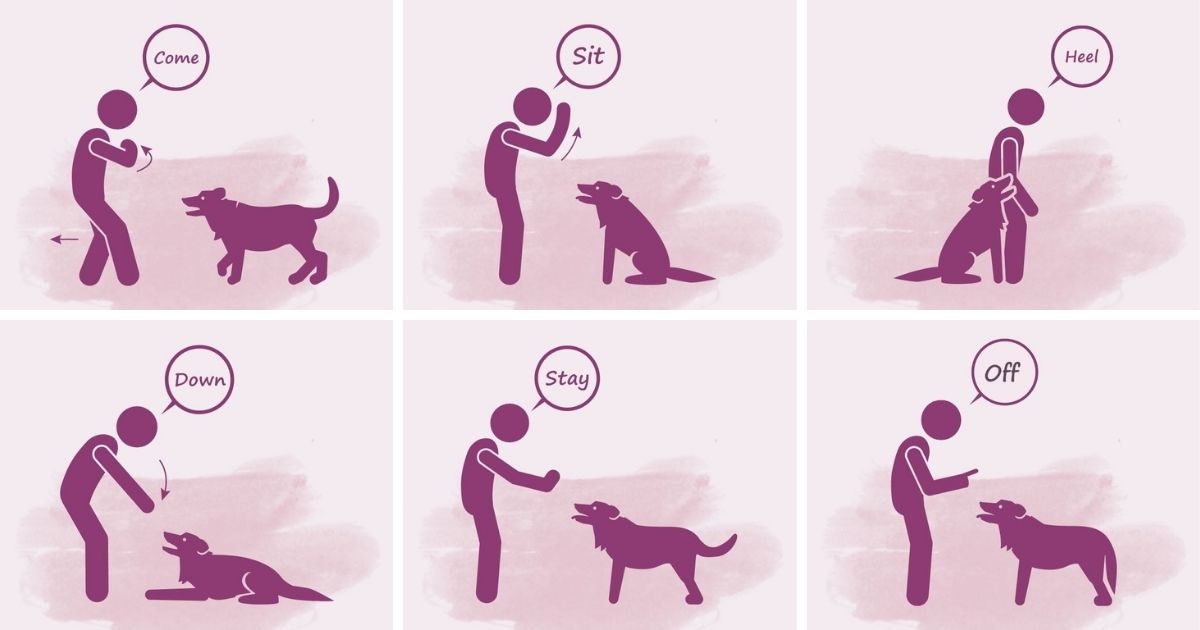You can’t own a dog without training it unless you’re fine with an ill-behaved pup that you’d be forced to abandon after its string of bad habits overwhelm you.
Much like feeding, vet checkup, exercise, and care, dog training is a basic need.
Some dog breeds are easier to train than others, but none should be neglected on the grounds of having a better temperament.
Dog obedience training is a core form of training you should give your pooch, and it involves getting it to learn and respond to basic dog commands.
There are seven basic commands many dog owners use, though canine commands aren’t limited to these.
Once your pup can learn and obey these seven commands: Sit, Stay, Come, Down, Heel, Off, Leave It, it will be on a good path to being well-mannered.
This guide will take you through the 7 basic dog commands, along with details on each.
As a bonus, you’ll also get some tips on dog training to help shape up your beloved pet buddy.
The 7 Basic Dog Commands To Teach Your Pup
01. Sit
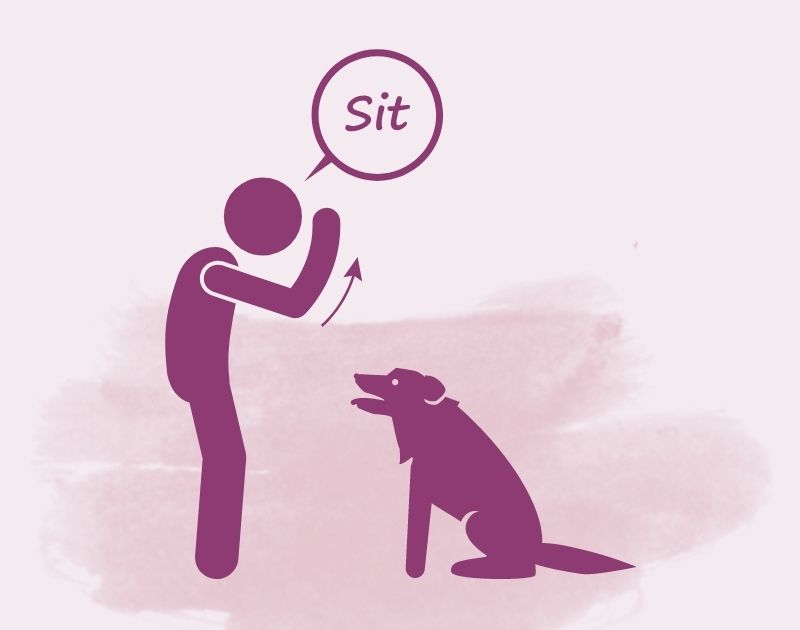
The Sit command is hands down the most popular and easiest command for dogs.
It is recommended you start with the Sit command as you can use it to calm your pooch down and keep it under control.
The Sit command also clears the path for other more complicated ones.
How to teach your dog the Sit command:
- Get a treat handy.
- Hold the treat close to your dog’s nose.
- Move your hand up in such a way that your dog’s head will follow the movement.
- Its bottom side will lower to a sitting position.
- Once it is in that position, say Sit.
- Reward with a treat and other forms of affection once it does.
Consistency is the key, so ensure you try it out multiple times a day till your dog can respond even without a treat.
You can then use the command during mealtime and when you need your dog to stay calm.
02. Stay
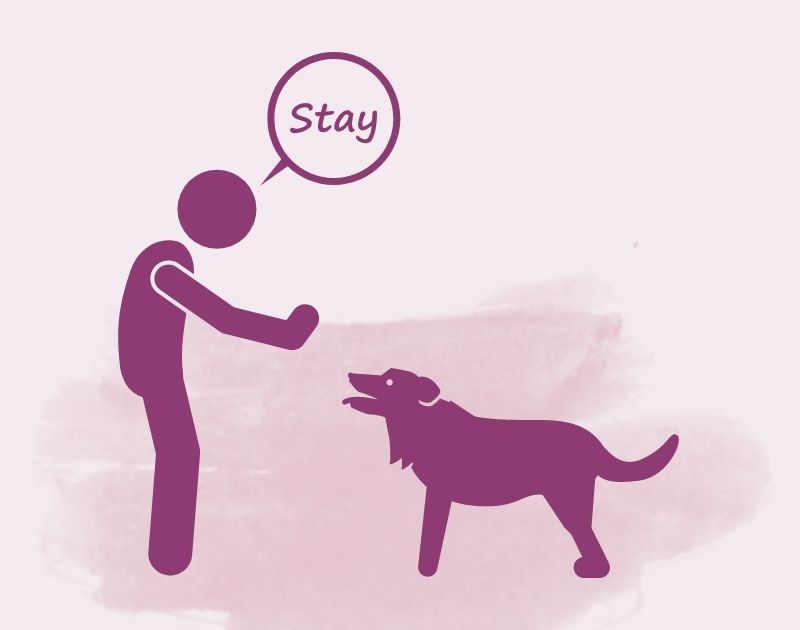
The Stay command shares a similar role with the Sit command in that it helps your dog remain calm.
You can use it when you don’t want your pet going after you as you step outdoors, or chasing after a nervous visitor.
The Stay command is also good for dogs that tend to run loose on the road.
Before teaching your dog the Stay command, ensure that it already understands and can respond to the Sit command as that would make your task more feasible.
If not, teach it the Sit command before proceeding to the Stay.
How to teach your dog the Stay command:
- Ask your dog to Sit.
- Open your palm and keep it in front of you.
- Say Stay.
- Take a few steps back.
- If your dog stays, reward it with a treat.
- Increase the distance a bit.
- Each time your dog stays, give it a treat, even if it only stayed for a few seconds.
The Stay command can be a bit difficult for a dog to master, especially for excitable puppies and hyperactive breeds.
A rule of thumb is to teach your dog the Stay command when it is tired and well-exercised. It might also take time, so you must be patient.
Once your dog masters the Stay command, it can save its life.
03. Come (Recall)
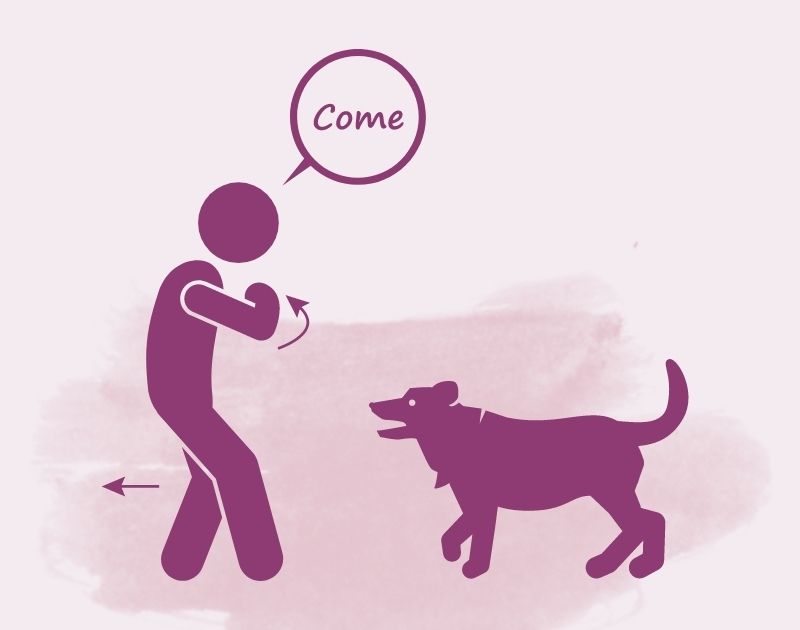
The Come command is relatively easy and is usually taught after the dog has mastered Stay.
A dog that has learned Stay would pick up Come fast. The Come command is helpful outdoors when your dog is off-leash or at a dog’s park.
Generally, it helped keep your dog out of trouble.
How to teach your dog the Come command:
- Put your dog on a leash or collar.
- Bend to its level and say Come.
- Gently pull on the leash.
- When the pooch responds, give it a treat.
When it can swiftly respond with the leash, remove the leash and teach it how to obey the command in a confined space.
04. Down
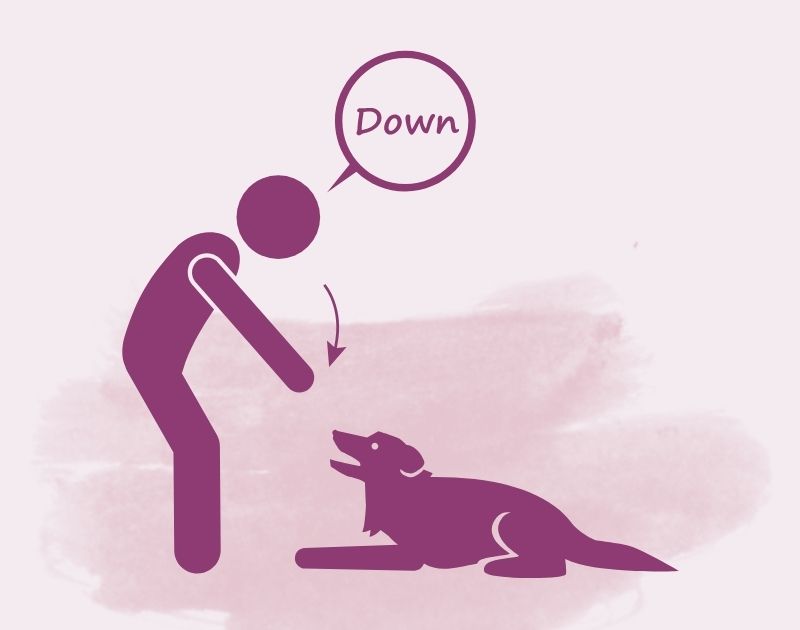
The Down command is a difficult one for a dog to master, especially independent breeds. It is even harder than the Sit or Stay.
One major reason is that it is one of the basic dog commands that require your dog to be submissive — a stance more complicated for stubborn dogs to take.
It is a good command nonetheless, as it can be effective in halting a dog on its tracks.
You’ll make more progress with this command by making training relaxed and positive, especially if your dog is stubborn or prone to anxiety.
Always reward your pooch when it obeys the command.
How to teach your dog the Down command:
- Get a treat your dog loves and hold it in closed hands.
- Hold your hand to your dog’s snout.
- Once your dog sniffs it, put your hand to the floor to encourage it to follow.
- Keep moving your hand forward till it gets to a lying position.
- Once it is in that position, say Down.
- Give it the treat once it obeys.
One challenge you’d have while teaching is that the dog might try to lunge at your hand or even sit up. Be sure to refute that with a No till it complies.
You might have to repeat this several times a day. Whatever you do, do not force your dog to get to the lying position. That would be counterproductive.
05. Heel
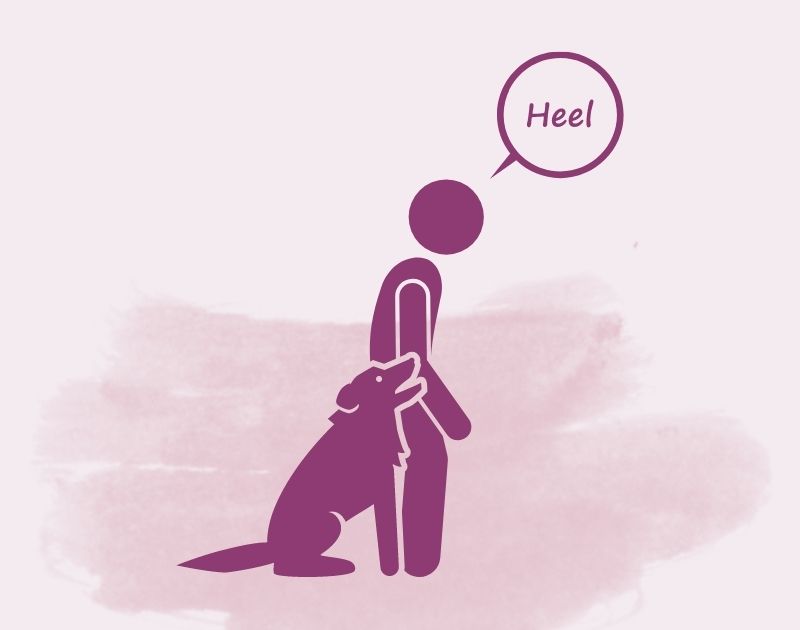
Getting a dog to Heel is training it to walk close to you, usually at the left side with 6 inches of space.
This is especially beneficial for dogs that have the habit of pulling at leashes or being overly excited.
The Heel command helps make your dog calmer during walks and makes exercises a better experience.
How to teach your dog the Heel command:
- Get some treats and a clicker (the clicker is optional).
- Find a spacious environment like an enclosed yard or a living room if you live in an apartment.
- Walk with your dog in that environment.
- While walking, say your dog’s name and point at the side you want it to walk at.
- When your dog responds favorably, say ‘yes’ or use the clicker.
- Hand a treat.
You’ll need to do this a couple of times till your dog will move to the side without you saying a word.
During the training, make it more challenging for the dog by increasing pace, zigzagging, or even turning.
06. Off
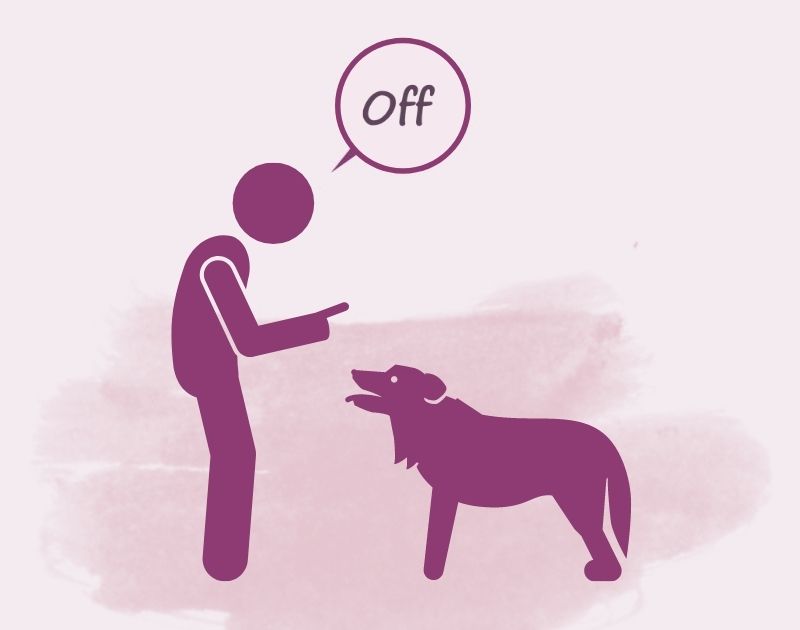
Do you fancy having your dog jump on you? Many dogs do this excitedly and mean no harm, but it can get overwhelming especially when your dog is too big.
It might also scare away a visitor when your friendly dog tries that. Even more, dogs can jump on pieces of furniture and might damage them.
Using the Off command can help curb this behavior and keep your dog under control when it is too excited.
There’s a slight difference between this command and others we’ve seen so far.
The Off command is meant to dissuade undesirable behaviors, not teach them how to act the same way.
How to teach your dog the Off command
- Have the treat on standby.
- Wait for your dog to jump on something/you.
- Say Off and use the sweet treat to distract someone.
- Practice consistently.
The best way to make sure your dog learns is to use it every time it jumps on you, a visitor, or an item of furniture.
By using the command and giving treats when it responds, your dog will eventually get accustomed to the command.
07. Leave It (Drop, No)
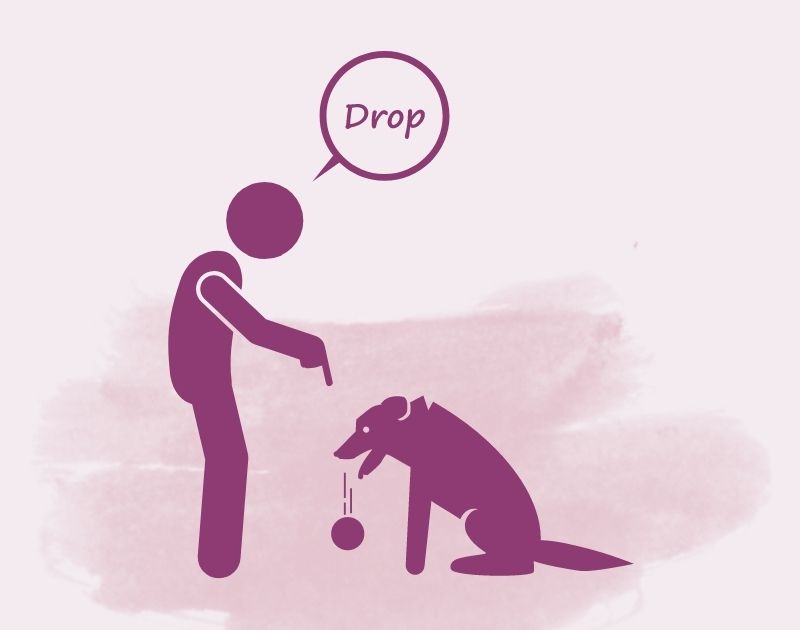
The 7th basic dog command on our list is Leave It.
This command is sometimes alternated with No or Drop as both words serve the same function: getting your dog to drop an object or ignore something potentially dangerous.
All dogs tend to be curious, especially when they are puppies. The Leave It command can keep them away from danger.
How to teach your dog the Leave It command:
- Hold treats in both hands and close your fists over them.
- Put one fist close to your dog and say Leave It.
- If your dog tries to get the treat, ignore it.
- Once it stops and steps back, hand over the treat from the other hand.
- Repeat it till the dog steps away from the first hand once you say Leave It.
Once it obeys consistently, make it more challenging. You can drop the first treat, cover it with your hand, and get it to Leave It.
The idea is to train it to turn away from something it is curious about to whatever else you have in hand.
You’d need to be patient as many dogs struggle with this particular training.
Tips on Dog Obedience Training
Teaching your dog to obey the commands above is vital in dog obedience training, but that is not all that dog training is about.
There are other things you should know when you want to train a puppy or an adult dog.
Obedience training is the first training a pooch needs, but it isn’t the only one. Socialization, house training, and crate training are some other examples.
Here are tips to make dog training a pleasant and successful experience:
Get advice from a veterinarian
If you’re wondering why you should visit a veterinarian for training, understand that dogs have different needs and even backgrounds.
If you adopted from a rescue shelter and the dog has problems with anxiety, or your dog suffers from a particular health condition (like deafness or blindness) you’ll need a veterinarian more.
The vet is in the best position to offer some beneficial suggestions and might even tell you how to handle a particular breed.
Have the right types of equipment
For training to be successful, you need a starter pack with the important tools. They include a short leash and a pack of healthy dog treats.
Start with basic commands
You have all the necessary commands in this guide. Teaching them these basic ones can help lay the foundation for other harder ones.
Use positive reinforcements
Treats are a form of positive reinforcement, but not the whole package.
Positive reinforcements also involve motivations, pats on the back, praise, or even toy games. Positive reinforcements encourage the dog to do better.
Remain in charge
As a pet parent, you must know how to assert dominance without being harsh.
Dogs usually understand the ‘pack system’, and the highly stubborn ones will only obey if they know you’re in charge.
This is why new pet parents are usually advised to get smaller and less stubborn breeds.
Once a dog understands that you’re superior, it would be more willing to please.
What is the best method to train a dog?
The best method one can use to train a dog is with positive reinforcements. This would encourage the dog to cooperate and also boost its self-esteem.
Dogs are motivated by what they like. This is why using harsh methods does more harm than good.
How many commands can a dog learn?
Dogs have different levels of intelligence, but they’ve all been known to learn a lot of words. The average dog breed can learn 165 words while breeds with a higher IQ can learn up to 250 words.
What order should I teach my dogs command?
There is no fixed rule for teaching a dog commands, but according to some experts, you can teach your dog basic commands following this order: Heel, Sit, Stay, Come…
What is the best age to train a dog?
It is always better to start training a dog when it is still a puppy and hasn’t begun developing any bad habits.
The ideal age is around 7 to 8 weeks where you start with gentle commands and positive reinforcements. You should also start socialization around this age.
Is it ever too late to start training your dog?
It is more challenging to train an adult dog as it would learn slower, but it is never too late to start training one.
So, do not despair when you adopt an adult dog. You’ll need to be more patient with it.
Summary
In conclusion, it is cool to train your dog how to do some more complex tricks like rolling over, giving a high five, winking, and even dancing.
But to get to that level, however, you need to establish the basic commands. The 7 basic dog commands on this guide are all good places to start.
Remember that consistency, calmness, and patience are important in dog training.
You should only train your dog during the moments when you’re in the right state of mind.
You should also get a breed that you can train as some are harder than others.
You May Also Enjoy:
Is Dog Board And Training Worth It? Pros & Cons
Reference & Notes
- Paisley Lunchick, “Teach Your Puppy These 5 Basic Cues,” American Kennel Club, Feb 03, 2021, accessed Mar 22, 2022, https://www.akc.org/expert-advice/training/teach-your-puppy-these-5-basic-commands/

